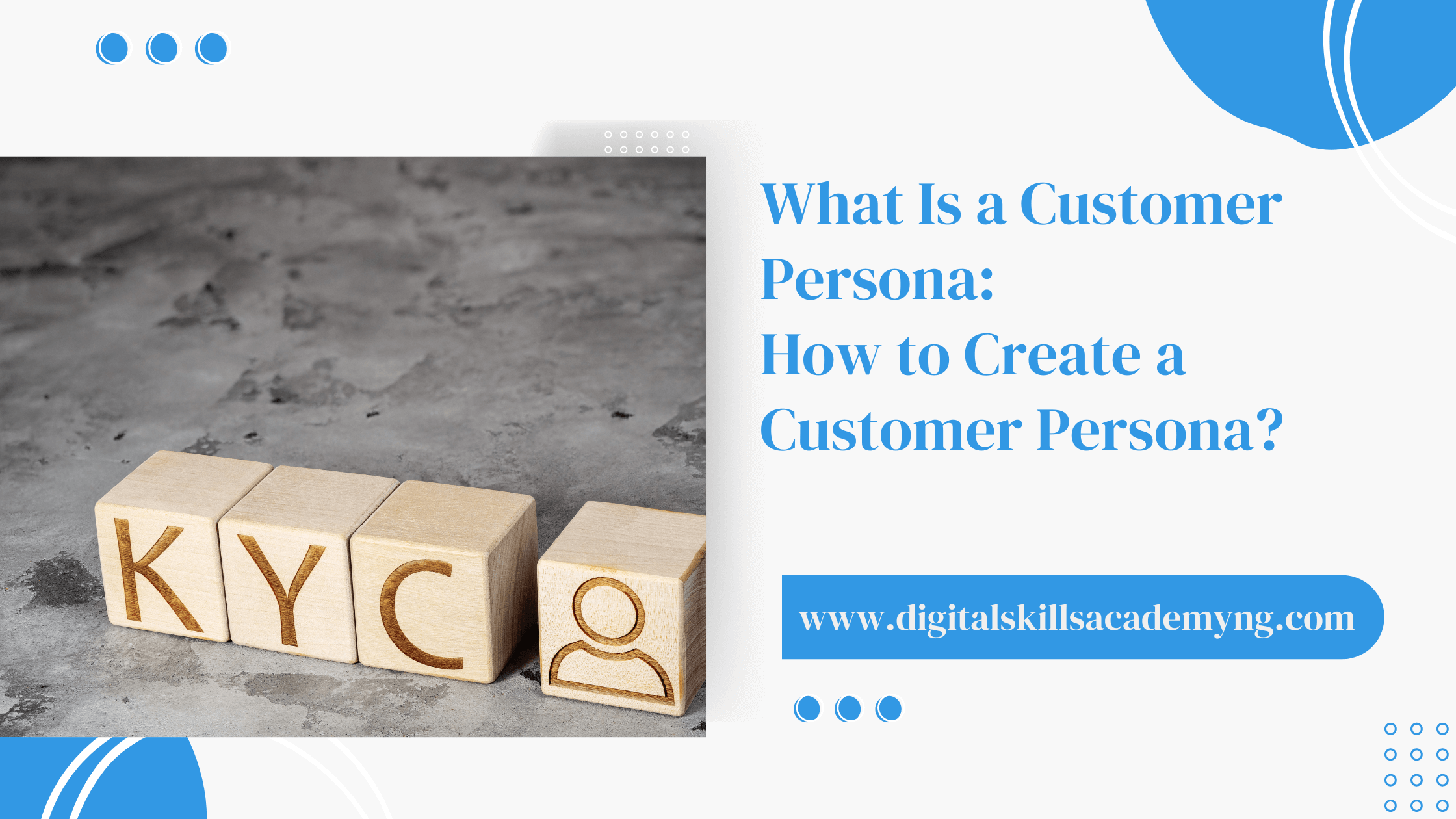What Is a Customer Persona: How to Create a Customer Persona?
Creating a customer persona is crucial in understanding your target audience and developing effective marketing strategies. A well-crafted customer persona allows you to tailor your products, services, and messaging to meet the specific needs of your ideal customers.
This blog post will explain a customer persona, the importance of creating one, and how to develop four common customer personas. We’ll also provide practical tips and examples to guide you.
What is a Customer Persona?
Table of Contents
A customer persona, also known as a buyer persona, is a semi-fictional representation of your ideal customer based on market research and accurate data about your existing customers.
These personas are detailed profiles that describe your target audience’s demographics, behaviors, goals, challenges, and purchasing patterns. They serve as a guide to help businesses understand their customers more deeply and create targeted marketing strategies.
Why are Customer Personas Important?
Customer personas are vital in various aspects of your business, including marketing, product development, customer service, and sales. Here’s why they are so important:
- Enhanced Marketing Efforts:
Understanding your customer personas can create more personalized and effective marketing campaigns. You’ll know which channels to use, what messaging resonates, and how to engage your audience effectively.
- Improved Product Development:
Personas help you identify the needs and pain points of your customers. This information is invaluable when designing or improving products and services that meet their specific demands.
- Better Customer Service:
Understanding your customers’ preferences and behaviors allows your customer service team to provide more tailored support, increasing satisfaction and loyalty.
- Streamlined Sales Processes:
With detailed customer personas, your sales team can better qualify leads, focus on the right prospects, and tailor their pitch to address the specific needs of different segments.
The Four Common Types of Customer Personas
When creating customer personas, it’s helpful to categorize them into different types based on their characteristics and behaviors. Below are four common types of customer personas:
- The Ideal Customer Persona
- The Negative (Exclusionary) Persona
- The Buyer’s Persona
- The User’s Persona
- The Ideal Customer Persona
The Ideal Customer Persona represents the perfect customer for your business—someone who benefits the most from your product or service and is most likely to purchase. High engagement, frequent purchases, and strong brand loyalty characterize this persona.
Demographics: Age, gender, location, education level, occupation, and income.
Behaviors: Purchasing habits, brand interactions, preferred communication channels, and decision-making process.
Goals: What are they trying to achieve using your product or service?
Challenges: What obstacles do they face that your product can help overcome?
Example:
Imagine you own a fitness app targeting busy professionals who want to stay fit but struggle to find time. Your Ideal Customer Persona could be:
Name: Sarah Thompson
Age: 35
Occupation: Marketing Manager
Location: Lagos
Income: $85,000/year
Challenges: Lack of time for gym workouts and stress from a high-pressure job.
Goals: Stay healthy, lose weight, and manage stress.
Preferred Communication: Email and social media.
Tips:
- Use data from your current customers to identify trends and common characteristics.
- Focus on those with a high lifetime value or repeat customers.
- Consider customer feedback and reviews to understand their needs and preferences.
- The Negative (Exclusionary) Persona.
The Negative Persona, also known as the exclusionary persona, represents the type of customer you don’t want to target. These individuals may not benefit from your product or service, are unlikely to make a purchase, or may even cost your business money.
Demographics: Similar to your ideal customer but with crucial differences that make them unsuitable.
Behaviors: Low engagement and frequent returns or complaints.
Challenges: Misalignment between their needs and your product offerings.
Example:
For a premium tech product designed for large enterprises, your Negative Persona could be:
Name: John Gorffery
Age: 28
Occupation: Freelancer
Location: Rural area
Income: $30,000/year
Challenges: Limited budget, prefers free or low-cost tools.
Goals: Keep operational costs low.
Tips:
- Analyze customer data to identify patterns of low engagement.
- Consider feedback from your sales and customer service teams regarding challenging customers.
- Focus on personas that do not align with your business goals or require disproportionate resources.
- The Buyer Persona.
The Buyer Persona is the decision-maker in the purchasing process. This persona focuses on understanding the factors influencing their buyer’s decisions, including motivations, concerns, and objections.
- Demographics: Age, gender, job title, industry, and decision-making authority.
- Behaviors: Research habits, preferred channels for information, and purchasing triggers.
- Goals: What business or personal goals drive their buying decisions?
- Challenges: What are their main concerns or objections when purchasing?
Example:
A software company targeting small to medium-sized businesses (SMBs) might create the following Buyer Persona:
Name: Martinez David
Age: 42
Occupation: IT Director
Company Size: 50200 employees
Location: Lagos
Goals: Improve team productivity, streamline operations, and stay within budget.
Challenges: Limited IT budget and concerns about software integration.
Tips:
- Conduct interviews with current customers who are the decision-makers.
- Focus on their pain points, decision criteria, and the factors influencing their choices.
- Identify common objections and how your product or service addresses them.
- The User Persona.
The User Persona represents the end user of your product or service. Unlike the buyer persona, which makes the purchasing decision, the user persona is concerned with the usability, features, and overall experience of your offering.
- Demographics: Age, gender, job role, technical proficiency, and daily responsibilities.
- Behaviors: How they interact with your product, usage patterns, and preferred features.
- Goals: What do they hope to achieve using your product or service?
- Challenges: What frustrations or difficulties do they encounter during use?
Example:
For a project management tool, a User Persona might look like this:
Name: Emma Johnson
Age: 30
Occupation: Project Manager
Company Size: 100 employees
Location: Abuja
Goals: Streamline project workflows and improve team collaboration.
Challenges: Managing multiple projects simultaneously and needing help tracking progress.
Tips:
- Gather user feedback through surveys, interviews, and usability tests.
- Please focus on the features and aspects of your product that are most important to them.
- Consider their technical expertise and how it affects their interaction with your product.
Steps to Create a Customer Persona
Now that we’ve explored the different types of customer personas let’s dive into the step-by-step process of creating them.
Step 1: Conduct Research
Start by gathering as much information as possible about your customers. This can include:
Customer Surveys: Create surveys to collect demographic information, preferences, and feedback on your product or service.
Interviews: Conduct one-on-one interviews with customers to gain deeper insights into their behaviors, goals, and challenges.
Website Analytics: Analyze website data to understand visitor behavior, including which pages they visit, how long they stay, and what actions they take.
Social Media Insights: Use social media analytics to learn about your audience’s interests, engagement levels, and content preferences.
Customer Support Data: Review customer support interactions to identify common issues, questions, and concerns.
Step 2: Segment Your Audience
Segment your audience into groups with similar characteristics based on the data collected. These segments can be based on demographics, behaviors, goals, or challenges. For example:
Demographic Segmentation: Age, gender, location, income, education level.
Behavioral Segmentation: Purchase history, product usage, brand loyalty.
Psychographic Segmentation: Lifestyle, values, interests, attitudes.
Step 3: Create Detailed Persona Profiles
For each segment, create a detailed persona profile. This profile should include:
Persona Name: Give your persona a name to make it more relatable (e.g., “Marketing Mary,” “TechHub Lit”).
Demographic Information: Age, gender, location, occupation, income, education level.
Behavioral Traits: Purchasing habits, preferred channels, decision-making process.
Goals and Motivations: What are their primary goals and motivations? What drives their purchasing decisions?
Challenges and Pain Points: What obstacles do they face? How can your product or service help them overcome these challenges?
Preferred Communication Channels: How do they like to receive information—email, social media, phone calls?
Step 4: Validate Your Personas
Once you’ve created your personas, you must validate them to ensure accuracy. You can do this by:
Sharing with Internal Teams: Present your personas to your sales, marketing, and customer service teams for feedback.
Testing with Real Customers: Compare your personas against real customers to see if they align with actual behaviors and preferences.
Iterating as Needed: Be prepared to refine and update your personas as you gather more data and insights.
Step 5: Use Personas to Guide Your Strategy
With your customer personas in place, you can now use them to inform various aspects of your business strategy:
Marketing Campaigns: Tailor your messaging, content, and channels to resonate with each persona.
Product Development: Design products and features that meet your personas’ needs and preferences.
Sales Tactics: Equip your sales team with the information they need to engage effectively with different personas.
Customer Support: Personalize your customer service approach to better address the concerns of each persona.
Examples of Customer Persona Profiles
Here are some examples of customer persona profiles for different industries:
Example 1: Fashion Brand
Persona Name: Fashion By Fiona
Age: 28
Occupation: Graphic Designer
Location: FCT Abuja
Income: $60,000/year
Challenges: Finding unique, trendy clothing that fits her style and budget.
Goals: Stay ahead of fashion trends and express individuality through her wardrobe.
Preferred Channels: Instagram, Pinterest, fashion blogs.
Example 2: TechHub Company
Persona Name: Operations Olivia
Age: 38
Occupation: Operations Manager
Company Size: 200 employees
Location: Port Harcourt
Goals: Streamline business processes and reduce operational costs.
Challenges: Managing multiple systems and tools on a limited budget.
Preferred Channels: LinkedIn, email newsletters, and industry webinars.
Example 3: Health & Wellness App
Persona Name: Health Conscious Henry
Age: 45
Occupation: Accountant
Location: Lagos
Income: $75,000/year
Challenges: Stay motivated to exercise regularly and manage stress from work.
Goals: Improve overall health, lose weight, and increase energy levels.
Preferred Channels: YouTube, fitness blogs, email.
Tips for Creating Effective Customer Personas
- Use Real Data: To ensure accuracy and relevance, base your personas on actual customer data whenever possible.
- Be Specific: The more detailed your personas, the more helpful they’ll be. Avoid vague descriptions and focus on specific traits and behaviors.
- 3. Keep Personas Updated: Customer behaviors and preferences can change. Regularly review and update your personas to keep them current.
- Involve Your Team: Collaborate with different departments to gather insights and ensure your personas reflect the perspectives of your entire organization.
- Test and Iterate: Use your personas as a starting point, but be open to making adjustments based on real-world feedback and results.
Conclusion
Creating customer personas is a powerful tool for understanding your target audience and crafting strategies that resonate with them. Whether you’re just starting or looking to refine your existing personas, the steps, and tips outlined in this blog post will help you create compelling and actionable customer personas that drive success.
Remember, the key to creating impactful personas is to base them on accurate data, be specific in your descriptions, and continuously validate and update them. With crafted customer personas, you’ll be better equipped to connect with your audience, meet their needs, and ultimately, grow your business.
Our certified Digital marketing course will teach you how to perform customer and business research, provide customer service strategies, develop a customer retention plan, and research all the key marketing channels to leverage them to engage your customers and grow your business.
What are you waiting for? Remember to share with friends.




